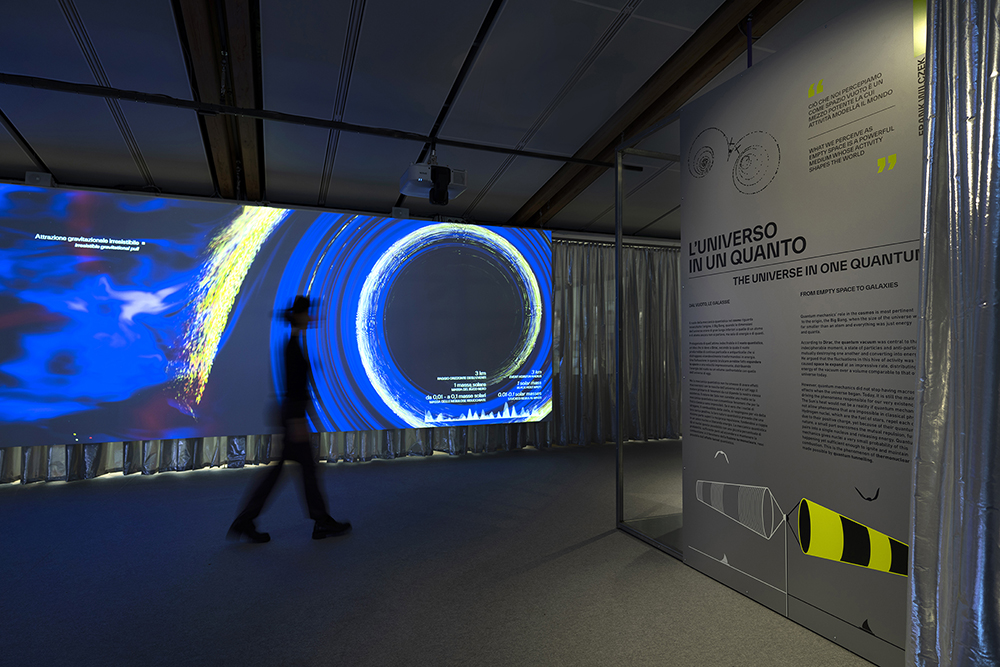 Counter-intuitive, shocking, fascinating. That’s quantum mechanics. It’s an idea that has overturned our way of seeing reality and understanding the universe. Its intriguing history and the cultural and technological revolution that it brought to science and society are recounted in the exhibition: Quantum. The revolution in one leap. Created by INFN and MUSE (the Science Museum of Trento), the exhibition is open to the public from 7 December 2023 to 15 June 2024.
Counter-intuitive, shocking, fascinating. That’s quantum mechanics. It’s an idea that has overturned our way of seeing reality and understanding the universe. Its intriguing history and the cultural and technological revolution that it brought to science and society are recounted in the exhibition: Quantum. The revolution in one leap. Created by INFN and MUSE (the Science Museum of Trento), the exhibition is open to the public from 7 December 2023 to 15 June 2024.
Between interactive multimedia installations and immersive scenography, the story unwinds across five stages, combining the immersive and experiential path with textual and visual narratives. The texts and videos explore the crucial themes of each stage, while modern and historic scientific instruments show the evolution of research methods and technologies and the impact that scientific thought and technologies have on society. The first section of the exhibition, Macrocosms, opens with the macroscopic world described by the comforting classical physics of Galileo, Newton, and Maxwell, considered the perfect description of physical reality at the end of the 19th century. Everything has an explanation, everything can be predicted: the fall of heavy bodies, celestial motions, wave phenomena, electricity, magnetism, light. The description of light itself, however, leaves a question open: where does light come from? In the second section, Microcosms, you explore the microscopic world, in the atom. Here, classical theory experiences a crisis and the need arises for a new description of the interaction between light and matter and, with this, a vision of the physical world that is far removed from the classical one. The idea of the quantum of light and the quantum leap is born. Discontinuity makes headway in the description of physical phenomena and launches a second question: what is the nature of light? Wave or particle? In the section Quanta, we are at the heart of the exhibition. Here you can experiment with the founding ideas of quantum mechanics: wave–particle duality, the superposition principle, and Heisenberg's uncertainty. Quantum mechanics describes the world as uncertain and probabilistic, made of overlapping realities and indeterminate properties. Being very difficult to accept for its own pioneers, it brings with it a profound question: what is reality? Paradoxes, the fourth stage of the show, goes through and beyond the 20th century. It recounts the debate between the great physicists Einstein, Bohr, Schrödinger, and Heisenberg, and the consequences it led to in scientific research and society. A synthesis of this debate, the pioneering experiments from the 1970s drag us into the new millennium, up until the Nobel Prize for Physics in 2022. This paves the way for quantum technologies, from cryptography to quantum computers. It is precisely the uncertainty that is intrinsic to the quantum world that, once understood and accepted, opens doors to unimaginable possibilities for advancements in knowledge and technology, which exploit and control bizarre quantum behaviours. If quantum mechanics has proved to describe not only microscopic reality, what does it say about the universe? How quantum is the cosmos? The exhibition concludes with the stage dedicated to the Cosmos, to macroscopic manifestations of quantum mechanics and the new, unsettling conception of the universe, where everything is quantum. Past and current experiments, which INFN leads as part of international collaborations, bring us ever closer to that first moment, the Big Bang. Here, the distinction between macroscopic and microscopic has no reason to exist.




